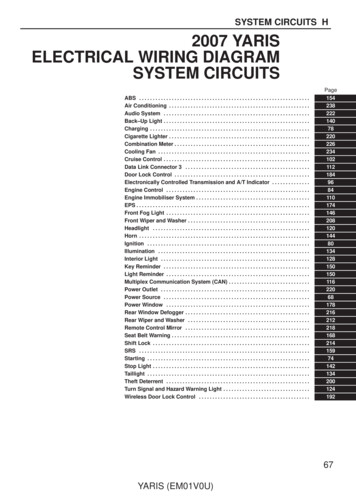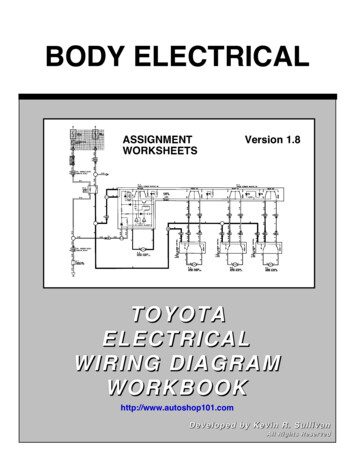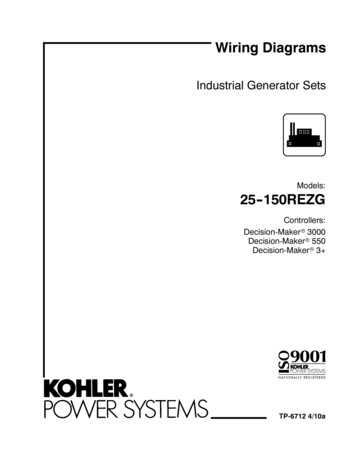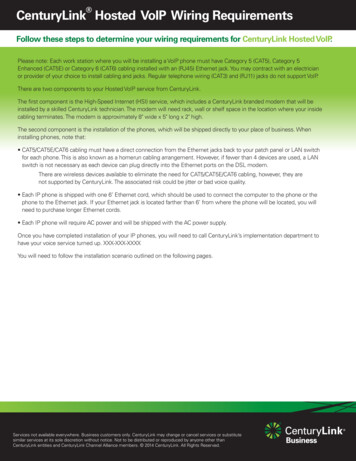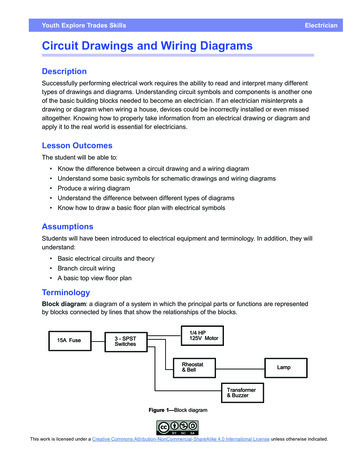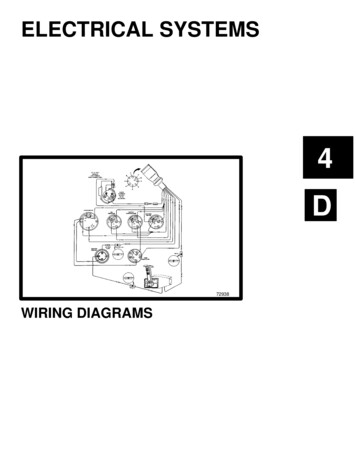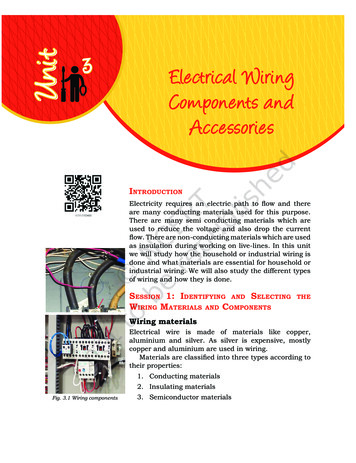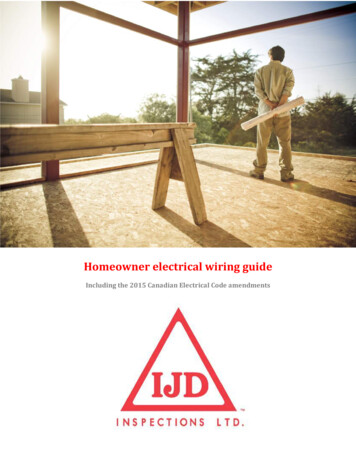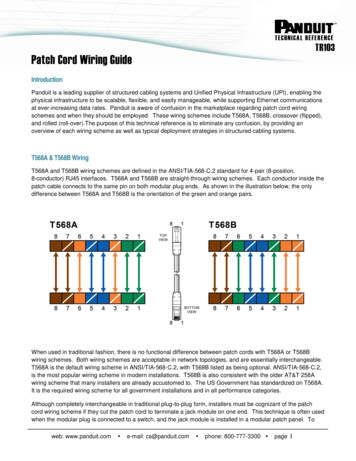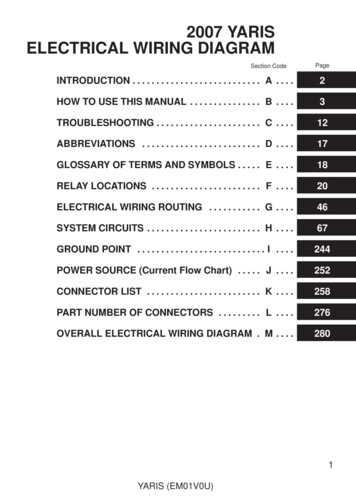
Transcription
2007 YARISELECTRICAL WIRING DIAGRAMSection CodePageINTRODUCTION . . . . . . . . . . . . . . . . . . . . . . . . . . . A . . . .2HOW TO USE THIS MANUAL . . . . . . . . . . . . . . . B . . . .3TROUBLESHOOTING . . . . . . . . . . . . . . . . . . . . . . C . . . .12ABBREVIATIONS . . . . . . . . . . . . . . . . . . . . . . . . . D . . . .17GLOSSARY OF TERMS AND SYMBOLS . . . . . E . . . .18RELAY LOCATIONS . . . . . . . . . . . . . . . . . . . . . . . F . . . .20ELECTRICAL WIRING ROUTING . . . . . . . . . . . G . . . .46SYSTEM CIRCUITS . . . . . . . . . . . . . . . . . . . . . . . . H . . . .67GROUND POINT . . . . . . . . . . . . . . . . . . . . . . . . . . . I . . . .244POWER SOURCE (Current Flow Chart) . . . . . J . . . .252CONNECTOR LIST . . . . . . . . . . . . . . . . . . . . . . . . K . . . .258PART NUMBER OF CONNECTORS . . . . . . . . . L . . . .276OVERALL ELECTRICAL WIRING DIAGRAM . M . . . .2801YARIS (EM01V0U)
A INTRODUCTIONThis manual consists of the following 13 sections:No.SectionDescriptionINDEXIndex of the contents of this manual.INTRODUCTIONBrief explanation of each section.BHOW TO USE THISMANUALInstructions on how to use this manual.CTROUBLE–SHOOTINGDescribes the basic inspection procedures for electrical circuits.DABBREVIATIONSDefines the abbreviations used in this manual.EGLOSSARY OFTERMS ANDSYMBOLSDefines the symbols and functions of major parts.FRELAY LOCATIONSShows position of the Electronic Control Unit, Relays, Relay Block, etc.This section is closely related to the system circuit.GELECTRICALWIRING ROUTINGDescribes position of Parts Connectors, Splice points, Ground points, etc.This section is closely related to the system circuit.INDEXIndex of the system circuits.SYSTEM CIRCUITSElectrical circuits of each system are shown from the power supply through groundpoints. Wiring connections and their positions are shown and classified by codeaccording to the connection method. (Refer to the section, ”How to use this manual”).The ”System Outline” and ”Service Hints” useful for troubleshooting are also containedin this section.IGROUND POINTShows ground positions of all parts described in this manual.JPOWER SOURCE(Current Flow Chart)Describes power distribution from the power supply to various electrical loads.KCONNECTOR LISTDescribes the form of the connectors for the parts appeared in this book.This section is closely related to the system circuit.LPART NUMBER OFCONNECTORSIndicates the part number of the connectors used in this manual.MOVERALLELECTRICALWIRING DIAGRAMProvides circuit diagrams showing the circuit connections.AH2YARIS (EM01V0U)
HOW TO USE THIS MANUAL BThis manual provides information on the electrical circuits installed on vehicles bydividing them into a circuit for each system.The actual wiring of each system circuit is shown from the point where the powersource is received from the battery as far as each ground point. (All circuitdiagrams are shown with the switches in the OFF position.)When troubleshooting any problem, first understand the operation of the circuitwhere the problem was detected (see System Circuit section), the power sourcesupplying power to that circuit (see Power Source section), and the ground points(see Ground Point section). See the System Outline to understand the circuitoperation.When the circuit operation is understood, begin troubleshooting of the problemcircuit to isolate the cause. Use Relay Location and Electrical Wiring Routingsections to find each part, junction block and wiring harness connectors, wiringharness and wiring harness connectors and ground points of each system circuit.Internal wiring for each junction block is also provided for better understanding ofconnection within a junction block.Wiring related to each system is indicated in each system circuit by arrows(from , to ). When overall connections are required, see the Overall ElectricalWiring Diagram at the end of this manual.3YARIS (EM01V0U)
B HOW TO USE THIS MANUAL* The system shown here is an EXAMPLE ONLY. It is different to the actualcircuit shown in the SYSTEM CIRCUITS SECTION.[A]Stop Light(BAT)[M](IG)15ASTOP7.5AGAUGE2[B]3 IB4 IBL(S/D)W–RR–L17 3C2[G][C]H6Stop Lamp SW15 3C14 CH14[E]138G–R3W–B[I](Shielded)2H17Center [N]StopStopG–RJ7Rear Combination Lamp (RH)G–R1HJ141H9Rear Combination Lamp (LH)[H]H4Light Failure ts15 CH1[K]H2[L]4YARIS (EM01V0U)H7Combination MeterR–LL(S/D)RG–WSkid Control ECUwith Actuator[D](W/G)1
B[A] : System Title[H] : Indicates the wiring color.Wire colors are indicated by an alphabetical code.[B] : Indicates a Relay Block. No shading is used andonly the Relay Block No. is shown to distinguish itfrom the J/BExample:Indicates Relay Block No.1[C] : () is used to indicate different wiring andconnector, etc. when the vehicle model, enginetype, or specification is different.B BlackW WhiteBR BrownL BlueVSB Sky Blue VioletR RedG GreenLG Light GreenPYGR Gray Pink YellowO OrangeThe first letter indicates the basic wire color and thesecond letter indicates the color of the stripe.[D] : Indicates related system.[E] : Indicates the code for the (male and female)connectors which are used to join two wireharnesses. The connector code consists of twoalphabetical and one numerical characters.Example:L–YL(Blue)[I]FemaleMale (Y(Yellow): Indicates a shielded cable.)The first character of the connector code indicatesthe alphabetical code allocated to the wire harnesswhich has the female connector, and the secondshows that of the wire harness which has the maleconnector.The third character indicates a serial number usedto distinguish between the wire harnesscombinations in cases when more than one of thesame combination of wire harnesses exist(e.g. CH1 and CH2).[J] : Indicates the pin number of the connector.The numbering system is different for female andmale connectors.Example: Numbered in otherfrom upper left tolower rightSymbol ( ) indicates the male terminal connector.Numbers outside connector codes indicate the pinnumbers of both male and female connectors.[F] : Represents a part (all parts are shown in sky blue).The code is the same as the code used in partsposition.[G] : Junction Block (The number in the circle is the J/BNo. and the connector code is shown beside it).Junction Blocks are shaded to clearly separatethem from other parts.FemaleNumbered in otherfrom upper right tolower leftMale[K] : Indicates the ground point. The code consists of thetwo characters: A letter and number.The first character of the code indicates thealphabetical code allocated to the wire harness.The second character indicates a serial numberused to distinguish between the ground points incases when more than one ground point exist on thesame wire harness.[L] : Page No.[M] : Indicates the ignition key position(s) when thepower is supplied to the fuse(s).Example:3C indicates thatit is insideJunction BlockNo.3[N] : Indicates a wiring Splice Point.Example:5YARIS (EM01V0U)
B HOW TO USE THIS MANUAL[O]System OutlineCurrent is applied at all times through the STOP fuse to TERMINAL 2 of the stop lamp SW.When the ignition SW is turned on, current flows from the GAUGE fuse to TERMINAL 8 of the light failure sensor, and also flowsthrough the rear lights warning light to TERMINAL 4 of the light failure sensor.Stop Light Disconnection WarningWhen the ignition SW is turned on and the brake pedal is pressed (Stop lamp SW on), if the stop light circuit is open, the currentflowing from TERMINAL 7 of the light failure sensor to TERMINALS 1, 2 changes, so the light failure sensor detects thedisconnection and the warning circuit of the light failure sensor is activated.As a result, the current flows from TERMINAL 4 of the light failure sensor to TERMINAL 11 to GROUND and turns the rear lightswarning light on. By pressing the brake pedal, the current flowing to TERMINAL 8 of the light failure sensor keeps the warningcircuit on and holds the warning light on until the ignition SW is turned off.[P]: Parts LocationCodeSee PageCodeSee PageCodeSee PageH436H736H1738H636H938J738[Q]: Relay BlocksCode1[R]See Page18Relay Blocks (Relay Block Location)R/B No.1 (Instrument Panel Brace LH): Junction Block and Wire Harness ConnectorCodeSee PageJunction Block and Wire Harness (Connector Location)3C22Instrument Panel Wire and J/B No.3 (Instrument Panel Brace LH)IB20Instrument Panel Wire and Instrument Panel J/B (Lower Finish Panel)[S]: Connector Joining Wire Harness and Wire HarnessCodeSee PageJoining Wire Harness and Wire Harness (Connector Location)CH142Engine Room Main Wire and Instrument Panel Wire (Left Kick Panel)HJ150Instrument Panel Wire and Floor Wire (Right Kick Panel)[T]: Ground PointsCodeSee PageGround Points LocationH150Under the Left Center PillarH250Back Panel Center6YARIS (EM01V0U)
B[O] : Explains the system outline.[P] : Indicates reference pages showing the parts locations in the system circuit on the vehicle.Example : Code ”H4” (Light Failure Sensor) is on page 36 of the manual.* The first character of the code indicates the alphabetical code allocated to the wire harness, and thesecond character indicates the serial number of the parts connected to the wire harness.Example : H 4ÁÁSerial number for the connected partsCode for the wire harness[Q] : Indicates the reference page showing the position on the vehicle of Relay Block Connectors in the system circuit.Example : Connector ”1” is described on page 18 of this manual and is installed on the left side of the instrumentpanel.[R] : Indicates the reference page showing the position on the vehicle of J/B and Wire Harness in the system circuit.Example : Connector ”3C” connects the Instrument Panel Wire and J/B No.3. It is described on page 22 of thismanual, and is installed on the instrument panel left side.[S] : Indicates the reference page describing the wiring harness and wiring harness connector (the female wiringharness is shown first, followed by the male wiring harness).Example : Connector ”CH1” connects the Engine Room Main Wire (female) and Instrument Panel Wire (male).It is described on page 42 of this manual, and is installed on the left side kick panel.[T] : Indicates the reference page showing the position of the ground points on the vehicle.Example : Ground point ”H2” is described on page 50 of this manual and is installed on the back panel center.7YARIS (EM01V0U)
B HOW TO USE THIS MANUALThe ground points circuit diagram shows the connections from all major parts to the respective ground points. Whentroubleshooting a faulty ground point, checking the system circuits which use a common ground may help you identifythe problem ground quickly. The relationship between ground points ( A1 , A2 and D4 shown below) can also bechecked this way.I GROUND POINT12HB49DB1BRBRW–BL5Power WindowMaster SWW–BA22Cooling FanMotor ConnectorA20Headlamp Leveling(LH E)Motor C3D43JunctionConnector610BR(L)D63ThrottlePosition SW(E1)D60InjectionPump Assembly(E1)(E01)D2Engine ECU(E02)W–B3W–BA5Pressure SWW–BA11WindshieldWiper Motor(E)I9HeadlampLeveling SW(E)A6Clearance Lamp(Front RH)(E)A21Clearance Lamp(Front IH2W–B7HA1W–BW–BW–B(E)C2Fog Lamp(Front LH)(E)C4Fog Lamp(Front RH)(E)A10Brake Fluid LevelWarning SW(E)A1Turn Signal Lamp(Front RH)(E)K5Power WindowMaster SWW–BA23Turn Signal Lamp(Front Headlamp Leveling(RH E)Motor (RH)W–BW–BW–B20 W – B(Shielded)19 W – B(Shielded)18 W – B(Shielded)17 W – W–B(GND)W–B6AB1W–BB19Skid Control ECUwith W–BA24Option Connector(Vacuum)W–BW–BA2*The system shown here is an EXAMPLE ONLY. It is different to the actual circuit shown in the SYSTEM CIRCUITS SECTION.8YARIS (EM01V0U)
BThe ”Current Flow Chart” section, describes which parts each power source (fuses, fusible links, and circuit breakers)transmits current to. In the Power Source circuit diagram, the conditions when battery power is supplied to each systemare explained. Since all System Circuit diagrams start from the power source, the power source system must be fullyunderstood.J POWER SOURCE (Current Flow Chart)The chart below shows the route by which current flows from the battery to each electrical source(Fusible Link, Circuit Breaker, Fues, etc.) and other parts10A ECU–B22Short Pin7.5A DOME15A EFIBattery230A AM26Fusible Link Block10A HAZARD220A RADIO NO.1S2Starter10A HORN6100A ALT560A ABSEngine Room R/B (See Page 20)20A10AFuseSystemPageSTOPABSABS and Traction ControlCruise ControlElectronically Controlled TransmissionMultiplex Communication System194187180166210DOMECigarette LighterCombination MeterHeadlightInterior LightKey Reminder and Seat Belt WarningLight Auto Turn Off SystemTheft Deterrent and Door Lock Control214230112122Power SourceB1BA1W1.25BFL MAINBattery50A MAINB217.5A DOME22W7AH1WW112R17.5A AM12122W–R6AH1W–RWB15A HAZ–RADIO2W84AM22AM11ST2IG2ST1IG1ACCH8Ignition SW220A DEFOGB–Y 1121W–RThe system shown here is an EXAMPLE ONLY. It is different to the actual circuit shown in the SYSTEM CIRCUITS SECTION.9YARIS (EM01V0U)
B HOW TO USE THIS MANUALK CONNECTOR LIST[A]A1A2A3BlackGray1 2 3 41 2 3 4 5 6 712345678[D][B]B1B2Black13[C]Gray24561 2 34 56 7 8 9 10111213K CONNECTOR LISTBA11 2 34 56 7 8 9 10 11 12 13BlackBD2[E]1 23 45 6 7 8 9 10 115 43 2 113 12 11 10 9 8 7 6Gray[F]4 32 111 10 9 8 7 6 5[A] : Indicates connector to be connected to a part. (The numeral indicates the pin No.)[B] : Junction ConnectorIndicates a connector which is connected to a short terminal.Junction ConnectorJunction connector in this manual include a short terminal which isconnected to a number of wire harnesses. Always performinspection with the short terminal installed.Short Terminal[C] : Parts CodeThe first letter of the code is taken from the first letter of part, and the numbers indicates its order in parts whichstart with the same letter.[D] : Connector ColorConnectors not indicated are milky white in color.[E] : Indicates the connector shapes which are used to join wire harnesses.On Left : Female connector shapesOn Right : Male connector shapesNumbers indicate pin numbers.[F] : Indicates connector colors. (Connectors with not indicated colors are white)10YARIS (EM01V0U)
BL PART NUMBER OF CONNECTORSPart NameCodePart NumberCodePart NamePart NumberA1Turn Signal Lamp (Front RH)90980–11019B22Door Courtesy SW (Front LH)90980–12470A2Inlet Air Temp. Sensor90980–11163B23Front Seat Outer Belt (LH)90980–12253A3Air Flow Meter90980–12292B24Blower SW (Rear Heater)90980–10463A4A/C Pressure Sensor90980–10845B25Front Seat Outer Belt (RH)90980–12253A5Pressure SW90980–10943B26Door Courtesy SW (Front RH)90980–12470A6Clearance Lamp (Front RH)90980–11156B27Cooling Fan ECU No.1Headlamp[B](RH)90980–11314[C]B28Cooling Fan ECU No.2Headlamp Leveling Motor (RH)90980–11016B29Water Temp. Sensor (Radiator)90980–10735A7[A]A890980–10841A9Brake Vacuum Warning SW90980–11252B30Fuel Filter Warning SW90980–11003A10Brake Fluid Level Warning SW90980–11207B32Door Control Relay (LH)90980–10789A11Windshield Washer Motor90980–11599B33Step Lamp (LH)90980–10121A12Airbag Sensor (Front RH)90980–11856B34Junction ConnectorA13Airbag SquibB35Junction Connector90980–1139890980–12490[A] : Part Code[B] : Part Name[C] : Part NumberToyota Part Number are indicated.Not all of the above part numbers of the connector are established for the supply.11YARIS (EM01V0U)
C TROUBLESHOOTINGTo Ignition SWIG Terminal(a) Establish conditions in which voltage is present at the checkpoint.Example:[A] – Ignition SW on[B] – Ignition SW and SW 1 on[C] – Ignition SW, SW 1 and Relay on (SW 2 off)Fuse[A]SW 1VOLTAGE CHECKVoltmeter[B](b) Using a voltmeter, connect the negative lead to a good groundpoint or negative battery terminal, and the positive lead to theconnector or component terminal.This check can be done with a test light instead of a voltmeter.Relay[C]SolenoidSW 2CONTINUITY AND RESISTANCE CHECK(a) Disconnect the battery terminal or wire so there is no voltagebetween the check points.Ohmmeter(b) Contact the two leads of an ohmmeter to each of the checkpoints.SWIf the circuit has diodes, reverse the two leads and checkagain.When contacting the negative lead to the diode positive sideand the positive lead to the negative side, there should becontinuity.When contacting the two leads in reverse, there should be nocontinuity.OhmmeterDiodeDigital TypeAnalog Type(c) Use a volt/ohmmeter with high impedance (10 kΩ/Vminimum) for troubleshooting of the electrical circuit.12YARIS (EM01V0U)
CFINDING A SHORT CIRCUITTo Ignition SWIG Terminal(a) Remove the blown fuse and disconnect all loads of the fuse.(b) Connect a test light in place of the fuse.(c) Establish conditions in which the test light comes on.Test LightFuse CaseExample:[A] – Ignition SW on[B] – Ignition SW and SW 1 on[C] – Ignition SW, SW 1 and Relay on (Connect theRelay) and SW 2 off (or Disconnect SW 2)Short [A]SW 1(d) Disconnect and reconnect the connectors while watching thetest light.The short lies between the connector where the test lightstays lit and the connector where the light goes out.Short [B]Disconnect(e) Find the exact location of the short by lightly shaking theproblem wire along the body.DisconnectLightRelayCAUTION:(a) Do not open the cover or the case of the ECU unlessabsolutely necessary. (If the IC terminals are touched,the IC may be destroyed by static electricity.)(b) When replacing the internal mechanism (ECU part) ofthe digital meter, be careful that no part of your body orclothing comes in contact with the terminals of leadsfrom the IC, etc. of the replacement part (spare part).Short [C]DisconnectSW 2SolenoidDISCONNECTION OF MALE AND FEMALECONNECTORSTo pull apart the connectors, pull on the connector itself, notthe wire harness.HINT : Check to see what kind of connector you aredisconnecting before pulling apart.Pull UpPull UpPress DownPress Down13YARIS (EM01V0U)
C TROUBLESHOOTINGHOW TO REPLACE TERMINAL(with terminal retainer or secondary locking device)Reference:1. PREPARE THE SPECIAL TOOL1031Example:(Case 1)1HINT : To remove the terminal from the connector, pleaseconstruct and use the special tool or like object shown onthe left.2. DISCONNECT CONNECTOR0.2(mm)UpTool3. DISENGAGE THE SECONDARY LOCKING DEVICE ORTERMINAL RETAINER.(a) Locking device must be disengaged before the terminallocking clip can be released and the terminal removed fromthe connector.(b) Use a special tool or the terminal pick to unlock the secondarylocking device or terminal retainer.NOTICE:Do not remove the terminal retainer from connector body.Terminal Retainer[A]Terminal RetainerFor Non–Waterproof Type ConnectorHINT : The needle insertion position varies according to theconnector’s shape (number of terminals etc.), socheck the position before inserting it.”Case 1”[Retainer at Full Lock Position]Raise the terminal retainer up to the temporary lockposition.StopperTerminalRetainer[Retainer at Temporary Lock Position]Example:(Case 2)SecondaryLocking Device”Case 2”Open the secondary locking device.14YARIS (EM01V0U)
CToolTabTabExample:(Case 1)[B]TerminalRetainerTool[Male]Access Hole(Mark)ToolFor Waterproof Type ConnectorHINT : Terminal retainer color is differentaccording to connector body.Example:Terminal RetainerBlack or WhiteBlack or WhiteGray or White: Connector Body: Gray: Dark Gray: Black[Female]”Case 1”Type where terminal retainer is pulledup to the temporary lock position (PullType).Insert the special tool into the terminalretainer access hole (YMark) and pullthe terminal retainer up to thetemporary lock position.Retainerat Full Lock PositionHINT : The needle insertion position variesaccording to the connector’s shape(Number of terminals etc.), so checkthe position before inserting it.Retainerat Temporary Lock Position[Male]Example:(Case 2)[Female]”Case 2”Type which cannot be pulled as far asPower Lock insert the tool straight intothe access hole of terminal retainer asshown.Terminal RetainerToolTool[Male]Press DownPress Down[Female]15YARIS (EM01V0U)
C TROUBLESHOOTINGPush the terminal retainer down to the temporary lock position.Retainer atFull Lock PositionRetainer atTemporary Lock Position[Male][Female](c) Release the locking lug from terminal and pull the terminal outfrom rear.Locking LugTool4. INSTALL TERMINAL TO CONNECTOR(a) Insert the terminal.HINT:1. Make sure the terminal is positioned correctly.2. Insert the terminal until the locking lug locks firmly.3. Insert the terminal with terminal retainer in the temporary lockposition.(b) Push the secondary locking device or terminal retainer in tothe full lock position.5. CONNECT CONNECTOR16YARIS (EM01V0U)
ABBREVIATIONS DABBREVIATIONSThe following abbreviations are used in this manual.A/C Air ConditioningA/T Automatic TransaxleABS Anti–Lock Brake SystemCAN Controller Area NetworkCPU Central Processing UnitEBD Electronic Brake Force DistributionECU Electronic Control UnitEPS Electric Motor Power SteeringH/B Hatchback TypeIC Integrated CircuitJ/B Junction BlockLED Light Emitting DiodeLH Left–HandM/T Manual TransaxlePTC Positive Temperature CoefficientR/B Relay BlockRH Right–HandS/D Sedan TypeSRS Supplemental Restraint SystemSW SwitchTEMP. TemperatureVSV Vacuum Switching Valvew/ Withw/o Without The titles given inside the components are the names of the terminals (terminal codes) and are not treated as beingabbreviations.17YARIS (EM01V0U)
E GLOSSARY OF TERMS AND SYMBOLSGROUNDThe point at which wiring attaches tothe Body, thereby providing a returnpath for an electrical circuit; without aground, current cannot flow.BATTERYStores chemical energy andconverts it into electrical energy.Provides DC current for the auto’svarious electrical circuits.CAPACITOR (Condenser)A small holding unit for temporarystorage of electrical voltage.CIGARETTE LIGHTERAn electric resistance heatingelement.HEADLIGHTSCurrent flow causes a headlight1. SINGLEFILAMENT filament to heat up and emit light. Aheadlight may have either a single(1) filament or a double (2) filament2. DOUBLEFILAMENTCIRCUIT BREAKERBasically a reusable fuse, a circuitbreaker will heat and open if toomuch current flows through it.Some units automatically reset whencool, others must be manually reset.HORNAn electric device which sounds aloud audible signal.DIODEA semiconductor which allowscurrent flow in only one direction.IGNITION COILConverts low–voltage DC currentinto high–voltage ignition current forfiring the spark plugs.DIODE, ZENERLIGHTCurrent flow through a filamentcauses the filament to heat up andemit light.A diode which allows current flow in onedirection but blocks reverse flow only upto a specific voltage. Above that potential,it passes the excess voltage. This acts asa simple voltage regulator.PHOTODIODEThe photodiode is a semiconductorwhich controls the current flowaccording to the amount of light.LED (LIGHT EMITTING DIODE)Upon current flow, these diodes emitlight without producing the heat of acomparable light.DISTRIBUTOR, IIAChannels high–voltage current fromthe ignition coil to the individualspark plugs.METER, ANALOGCurrent flow activates a magneticcoil which causes a needle to move,thereby providing a relative displayagainst a background calibration.FUSEMETER, DIGITALCurrent flow activates one or manyLED’s, LCD’s, or fluorescentdisplays, which provide a relative ordigital display.A thin metal strip which burns throughwhen too much current flows through it,thereby stopping current flow andprotecting a circuit from damage.FUELFUSIBLE LINK(for Medium Current Fuse)(for High Current Fuse orFusible Link)A heavy–gauge wire placed in highamperage circuits which burns through onoverloads, thereby protecting the circuit.The numbers indicate the crosssectionsurface area of the wires.M18YARIS (EM01V0U)MOTORA power unit which convertselectrical energy into mechanicalenergy, especially rotary motion.
ERELAYBasically, an electrically operated1. NORMALLYswitch which may be normallyCLOSED closed (1) or open (2).Current flow through a small coilcreates a magnetic field which eitheropens or closes an attached switch.2. NORMALLYOPENRELAY, DOUBLE THROWA relay which passes currentthrough one set of contacts or theother.SPEAKERAn electromechanical device whichcreates sound waves from currentflow.SWITCH, MANUALOpens and closescircuits, thereby1. NORMALLYstopping (1) orOPENallowing (2) currentflow.2. NORMALLYCLOSEDRESISTORAn electrical component with a fixedresistance, placed in a circuit toreduce voltage to a specific value.SWITCH, DOUBLE THROWA switch which continuously passescurrent through one set of contactsor the other.RESISTOR, TAPPEDA resistor which supplies two ormore different non adjustableresistance values.SWITCH, IGNITIONA key operated switch with severalpositions which allows variouscircuits, particularly the primaryignition circuit, to becomeoperational.RESISTOR, VARIABLE or RHEOSTATA controllable resistor with a variablerate of resistance.Also called a potentiometer orrheostat.(Reed Switch Type)SENSOR (Thermistor)A resistor which varies its resistancewith temperature.SWITCH, WIPER PARKAutomatically returns wipers to thestop position when the wiper switchis turned off.SENSOR, SPEEDUses magnetic impulses to openand close a switch to create a signalfor activation of other components.TRANSISTORA solidstate device typically used asan electronic relay; stops or passescurrent depending on the voltageapplied at ”base”.SHORT PINUsed to provide an unbrokenconnection within a junction block.SOLENOIDAn electromagnetic coil which formsa magnetic field when current flows,to move a plunger, etc.WIRESWires are always drawn as(1) NOTstraight lines on wiringCONNECTED diagrams.Crossed wires (1) without ablack dot at the junction arenot joined;crossed wires (2) with ablack dot or octagonal ( )(2) SPLICEDmark at the junction arespliced (joined)connections.19YARIS (EM01V0U)
F RELAY LOCATIONS[Engine Compartment](H/B)Engine Control ModuleFusible Link BlockSkid Control ECU with ActuatorEngine Room R/BEngine Room J/BEngine RoomR/B No.2(S/D)Engine Control ModuleFusible Link BlockSkid Control ECU with ActuatorEngine Room R/BEngine Room J/BEngine RoomR/B No.220YARIS (EM01V0U)
F[Instrument Panel](H/B)Power Steering ECUTransponder Key ECUTheft Warning ECUFront Fog LightRelayFuse BlockRunning LightRelayACC CutRelayJ/B No.6Main BodyECUInstrumentPanel J/BShift LockControl ECUJ/B No.5Transponder KeyAmplifierAirbag SensorA/C Amplifier Assembly Center(S/D)Power Steering ECUTransponder Key ECUTheft Warning ECUFuse BlockRunning LightRelayACC CutRelayJ/B No.6Main BodyECUInstrumentPanel J/BShift LockControl ECUFront FogLight RelayJ/B No.5Transponder KeyAmplifierAirbag SensorA/C Amplifier Assembly Center21YARIS (EM01V0U)
F RELAY LOCATIONS[Body](5–Door)Occupant Classification ECUDoor Control Receiver(3–Door)Occupant Classification ECUDoor Control Receiver22YARIS (EM01V0U)
F(4–Door)Occupant Classification ECUDoor Control Receiver23YARIS (EM01V0U)
F RELAY LOCATIONS1: Engine Room R/B: Engine Room J/BEngine Compartment Left (See Page 20)ABS2/VSC22 30A 1* 1:H-LP LH/H-LP LO LH* 2:H-LP RH/H-LP LO RH* 3:30A HTR SUB1 (for High Current)* 4:30A RDI (for High Current)* 5:40A HTR (for High Current)* 6:50A ABS1/VSC1 (for High Current)* 7:50A EPS (for High Current)* 8:40A HTR SUB2 (for High Current)* 9:FAN NO.2 Relay* 10:ST Relay*102Unit AEFI1 20A 2112 4 15353HTR SUB1Relay5 3*92*312*12 10A 1*22 10A 1*41212HAZ2 10A 1ECTS2 10A 1ALT-S2 7.5A 1ECU-B2 7.5A 1DOME2 15A 1*6HORN1 10A 212*712*8AM21 15A 212EFI22 10A 1*5ST2 30A 11D1E1(from Engine RoomMain Wire)Wire Color : B1(from Engine RoomMain Wire)Wire Color : WUnit B24YARIS (EM01V0U)
F123456781234567812341A5678(from Engine RoomMain Wire)12341B5678(from Engine RoomMain Wire)1C11(from Engine RoomMain Wire)Unit A25YARIS (EM01V0U)
F RELAY LOCATIONS[Engine Room R/B and Engine Room J/B Inner Circuit]Unit A1 1AEFI Relay124 1A20A EFI3 1A2 1A5 1AHORN Relay128 1A10A HORN7 1A6 1A1 1B12IG2 Relay4 1B15A AM23 1B2 1B5 1BFAN NO.1 Relay8 1B7 1B6 1B1 1C26YARIS (EM01V0U)
F1Unit B230A ABS2/VSC21230A HTR SUB11230A RDI1240A HTR1250A ABS1/VSC11250A EPS121 1E111111140A HTR SUB21210A H-LP LH/H-LP LO LH1210A H-LP RH/H-LP LO RH1210A HAZ1210A ETCS127.5A ALT-S127.5A ECU-B1215A DOME121 1D1111111130A ST27YARIS (EM01V0U)
F RELAY LOCATIONS2: Engine Room R/B No.2 Engine Compartment Right (See Page 20)HTR SUB2 Relay2153351H-LP/AMT Relay23512HTR SUB3 Relay28YARIS (EM01V0U)
Memo29YARIS (EM01V0U)
F RELAY LOCATIONS: Instrument Panel J/BLower Finish Panel (See Page 21)16151413121110 98 7 6 5 4 3 2 1141312 1110 9 87 6 5 4 3 2 119 120 22122232425263456784B(from InstrumentPanel Wire)4D27 928 1029 1130 1231 1332 1433 1534 1635 1736 181234(from Engine RoomMain Wire)1617181912344A20 521 622 723242526(from InstrumentPanel Wire)891011161718191 192 203456785 206 217 228 239 2410 2511 269 2710 2811 2912 3012 2713 2814 2915 3013 3114 3215 3316 3417 3518 361 3452 627 1228 1329 1430 154C76543211413121110 9 8212223242526(from InstrumentPanel Wire)4H1 172 1834567817 118 21920212223241920212223249 2510 2611 2712 2843214E29 1330 1431 1532 1621113287(from InstrumentPanel Wire)165443214J3 1456 2(from Roof Wire)30A POWER(for High Current)4K1155348 7 6 5 432 13(from InstrumentPanel Wire)2234567825 926 1027 1128 1213 2914 3015 3116 322(from Floor Wire)8765432116151413121110 918 917 816 715 614 513 412 311 210 119 188 177 166 155 144 133 122 111 104F30A DEF(for High Current)14562378(from InstrumentPanel Wire)4LIG 1 Relay14GHTR Relay1FLASH Relay(from Engine RoomMain Wire)(from Engine RoomMain Wire)30YARIS (EM01V0U)
F1234567891011121314151617181920212223242526Main Body ECU4M12 1110 9 8 76 5 4 3 2 17 8 9 10 11121 2 3 4 5 610 11121314 151617 181 2 3 4 5 6 7 8 96 7 8 9 101 2 3 4 56 7 8 9 10 1112134 51 2 34Q13121110 9 8 7 654321(from InstrumentPan
Internal wiring for each junction block is also provided for better understanding of connection within a junction block. Wiring related to each system is indicated in each system circuit by arrows (from_, to_). When overall connections are required, see the Overall Elec


